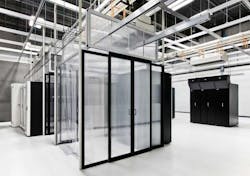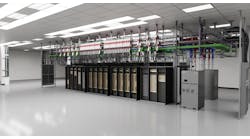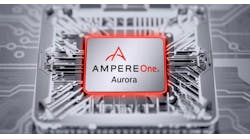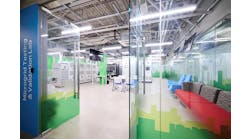DANBURY, Ct. – Aligned Data Centers is building a different kind of data center company, focusing on a particular problem – the cost of capacity for future growth.
It is approaching this problem on three levels, pursuing innovation in cooling, the supply chain and pricing models.
Aligned is targeting one of the toughest challenges in the data center business. Cloud builders and service providers are growing fast, and need access to data center space so they can rapidly add servers and storage. Estimating future demand remains an inexact science, so these tenants procure large chunks of space to ensure “headroom” for growth.
The problem is that data center space is expensive, and expansion space often sits vacant until demand materializes, meaning the customer is often paying for space it’s not using.
“We founded Aligned to go after the data center capacity problem,” said Jakob Carnemark, the CEO of Aligned Data Centers. “We wanted to deliver an infrastructure model where you didn’t have to guess.”
After several years of supporting clients using its cooling technologies, Aligned is now moving aggressively into the colocation business. It is building large data centers in the Dallas and Phoenix markets, and aims to add facilities in four other major markets: northern New Jersey, Northern Virginia, Chicago and California.
Aligned is building big. Its Dallas facility is 300,000 square feet with 30 megawatts of power capacity, while the Phoenix site is 550,000 square feet and planned for 65 MW of power. But the key to its approach is making efficient use of the space inside those large buildings, emphasizing granular control of the cooling costs and customer footprint.
An illustration of the huge Phoenix data center being developed by Aligned Data Centers. (Image: Aligned Data Centers)
“We see our role as a lean supplier to the infrastructure layer,” said Carnemark. “We wanted to approach this as a supply chain, and take infrastructure utilization off the table by selling it as a utility model.”
In a nutshell, Aligned hopes to bring cloud-style pricing and hyperscale-level efficiency into the multi-tenant data center sector.
The “Pay for Use” Model
Aligned is leading with its “pay for use” pricing model, which allows customers to start small while reserving adjacent space for expansion. Let’s say a customer wants 1 megawatt of expansion capacity, but will only have 250kW of equipment to deploy immediately. Under existing wholesale pricing models, the customer could lease a 1 megawatt data hall to ensure that the 750kW of contiguous space will be available.
Aligned offers a two-tiered pricing structure that allows the customer to control the full 1 megawatt of space, paying to power and cool the 250kW it is using, while paying a lower rate (about a third of the fee for utilized space) to control the remaining 750kW of capacity. When the customer adds another 250kW, it will pay for 500kW at the utilized rate, and 500kw at the rate for unused space. Carnemark likens it to a utility approach, with a baseline fee for the space and usage-based pricing for power and cooling.
An overview of Aligned Data Centers’ pricing model. (Source: Aligned Data Centers)
“The utility model is pay for what you use,” he said. “It’s the same thing the utility industry did 100 years ago. We want to make the data center adaptable and always have high utilization.”
The challenge with this approach has been making the economics of the business model work, so that the data center operator’s costs are aligned with the customer revenue – hence, the “Aligned” in the company’s name.
“The biggest market moat is the business model,” said Carnemark.
Aligned approaches data center economic challenges in two ways. It uses a modular design, building out customer space in increments using pre-fabricated enclosures to manage customer growth and capital costs. The other stumbling block for multi-tenant data center providers is managing density, which can vary from customer to customer, and thus from cabinet to cabinet. That’s why cooling is central to Aligned’s world view.
Inside the Data Center Science Lab
The secret sauce behind Aligned’s cooling design is developed in an R&D facility in Danbury, Ct. operated by Inertech, a business unit of Aligned that has developed modular containment systems to deliver efficient cooling. Aligned’s business and operations teams work in offices in the front half of the building, preparing for the upcoming launch of the company’s first facility. But a short walk to the rear of the building unveils a data center science lab, where Inertech prototypes and refines its technology.
Inertech describes its approach as a “dynamic fit” passive cooling system that offers a more flexible approach than other modular data center designs. Inertech’s refrigerant-based system has multiple components:
- A rack enclosure using hot aisle containment.
- A cooling unit known as an eSync that sits atop the enclosure.
- A cooling distribution unit (CDU).
- A pump house that provides low-energy pumps.
- A “cactus cooler” unit that rejects the heat outside the building.
The eSYNC cooling unit sits on top of the enclosure, and uses a refrigerant system and heat sink to cool exhaust heat from the hot aisle and return it to the front of the enclosure and the server inlets. The refrigerant is pumped by a cooling distribution unit (CDU) with a heat exchanger that allows the system to use free cooling – tapping cool outside air to support the cooling system. There are two cooling coils in the eSync unit, which uses variable speed fans and is supported by two separate CDU loop for refrigerant to create 2N reliability. There’s no water in the data hall, and the system can handle up to 30kW in power density per cabinet.[clickToTweet tweet=”Jakob Carnemark: We wanted to approach this as a supply chain.” quote=”Jakob Carnemark: We wanted to approach this as a supply chain.”]
The cactus cooler uses evaporative cooling with a water media to reduce water usage compared to a standard cooling tower, but has a compressor to “trim” the temperature during summer months if needed. Aligned says the system can operate in passive mode through the majority of the year in most climates.
The entire design is optimized to reduce the energy needed to move air and refrigerant through the system. Inertech has created a cooling backplane (thermal bus) that can be incrementally expanded by adding a CDU as customers add capacity. A video flythrough offers a visual overview of the design.
Earl Keisling, the CEO of Inertech, says the design can handle variable workloads, operating efficiently at different power densities and temperatures.
“What we designed is a small cooling package in 350kW blocks that can have good efficiency at low load and high load,” said Keisling. “It’s not a cooling problem, it’s a heat absorption problem. What you’re actually trying to do is remove the waste heat.”
The eSYNC cooling unit sits on top of the enclosure, and uses a refrigerant system to cool exhaust heat from the hot aisle and return it to the front of the enclosure and the server inlets. (Photo: Rich Miller)
The Aligned design varies slightly from the best-known implementation of Inertech designs, a Telus data center that uses a rear door cooling unit rather than the overhead eSync. Telus says the design delivered on an SLA for a Power Usage Effectiveness (PUE) of 1.15.
The system got a vote of confidence from Steve Fairfax, an expert on reliability and regular speaker at data center conferences.
“Aligned Data Centers is the first data center provider we have seen to architect itself from day one to deliver a more reliable platform,” writes Fairfax, President of MTechnology, in an evaluation of the technology. “From its use of the most reliable cooling platform we have ever evaluated, to its selection of generation platforms, they are the first provider to focus on reliability centered improvements from design through operations.”[clickToTweet tweet=”Steve Fairfax: Aligned uses the most reliable cooling platform we have ever evaluated.” quote=”Steve Fairfax: Aligned uses the most reliable cooling platform we have ever evaluated.”]
Optimizing the Supply Chain
Pricing and cooling are two key elements in Aligned’s larger vision for the industry, which has guided the structure and evolution of the company.”We look at everything in terms of how we reduce the cost at the lowest use (load),” said Carnemark.
Aligned is backed by private equity firm BlueMountain Capital Management through its Summit Fund II, an investment vehicle backed by $1.3 billion. BlueMountain has a total of $22 billion in assets under management.
Aligned brings together a collection of companies that each contribute a piece of the larger vision. Aligned Energy is the parent holding company, which operates four business units: Aligned Data Centers, cooling specialist Inertech, building management software company Energy Metrics, and design and engineering firm Karbon Engineering.
The Aligned team has been growing. In October, the company hired three industry veterans: Chief Operating Officer Thomas Doherty (previously at Verizon), Chief Financial Officer Mark Gibbens (experience at GM and Alcatel-Lucent) and Director of Operations Paul Fox, who managed data centers for Morgan Stanley, Goldman Sachs, UBS and JP Morgan Chase.
Aligned Data Centers CEO Jakob Carnemark (right) and Inertech CEO Earl Keisling. (Photo: Rich Miller)
Carnemark spent 12 years at Skanska as a senior vice president of their mission-critical facilities operation. That’s where he connected with Keisling and began deploying Inertech’s cooling solutions at major data centers, most notably two facilities for Telus in Canada. Aligned was formed in 2013.
“It’s been a long journey,” said Carnemark.
And now it’s ready to come to market, with the Dallas facility holding a launch event on Nov. 19.
Aligned has built the team, the technology and the strategy, but must now compete against established players in some of the most competitive markets for wholesale data center space. There’s strong demand and absorption rates in these markets, yet Aligned will be targeting some of the same type of customers – large enterprises, managed service providers and cloud companies – that have been leasing space from existing wholesale players.
Carnemark believes large users will find Aligned’s approach compelling. “We’re not cheaper at 3kW per rack,” he said. “But for a managed services and cloud player (with higher density), I don’t see how you stay competitive without building out your own data center or going to a utility model.”






